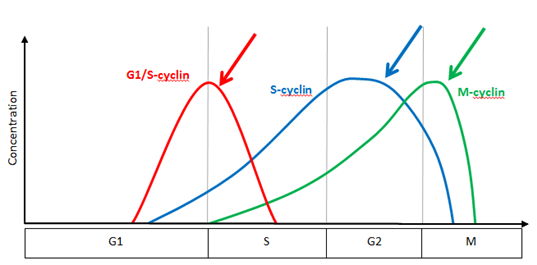In bryophytes:
A. the diploid gametophyte produces haploid
spores by meiosis.
B. the haploid gametophyte produces diploid
spores by fertilization.
C. the male gametes require water to reach
the female gametes.
D. the male gametes are dispersed by wind.
E. the sporophyte produces spores by
mitosis.
C
You might also like to view...
The following graph represents the concentration of cyclins over the course of the cell cycle. Which of the following statements is TRUE regarding the phase of the cell cycle where the red arrow is pointing?

A. At this point in the cell cycle, all sister chromatids are fully formed.
B. At this point in the cell cycle, DNA has already been replicated correctly.
C. At this point in the cell cycle, chromosomes have properly aligned on the metaphase plate and are beginning to separate.
D. At this point in the cell cycle, the cell is determining if conditions are favorable for cell division.
E. At this point in the cycle the cell is continuing to grow and make abundant tubulin proteins.
As you examine a soil sample under your microscope, you note the presence of tiny, wormlike organisms. You immediately suspect that these creatures are nematodes. The presence of which characteristics would support your hypothesis? Check all that apply.
_____ longitudinal but not circular muscles. _____ separate male and female individuals. _____ shedding of the integument. _____ a tough, collagen-based cuticle. _____ abundant flame cells,
Imagine an earthworm that has no chaetae. How would the lack of chaetae affect movement of the earthworm?
A. The earthworm would be much flatter than normal since it has no hydrostatic skeleton. B. The earthworm would only be able to extend its body segments. C. The earthworm would only be able to shorten its body segments. D. The earthworm would have difficulty changing locations, since it cannot anchor itself in the soil. E. The earthworm would not be able to move at all.
What nucleoside trisphosphate, other than ATP, provides some of the energy for protein synthesis?
A. GTP B. TTP C. CTP D. UTP